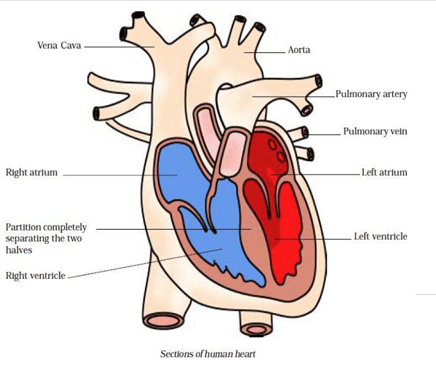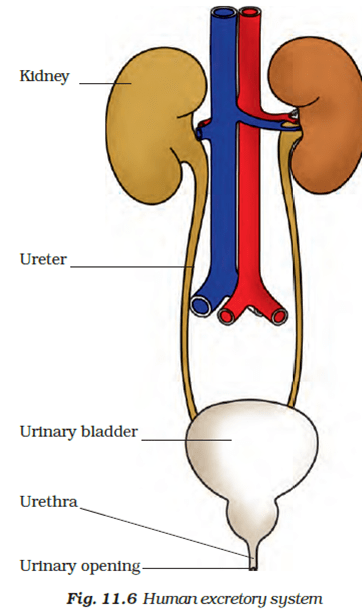NCERT Solutions Class 7 Science Chapter 7 Transportation in Animals and Plants is provided here to help students in understanding the topic thoroughly. All these solutions are solved by experts with a detailed explanation. Class 7 NCERT Solutions for Science Chapter 7 includes all the textbook exercise questions and answers. These solutions will help students complete their assignments & homework.
Class 7 Science Transportation in Animals and Plants Questions and Answers
Exercise Questions
Question 1: Match structures given in Column I with functions given in Column II.
| Column- I | Column-II |
| (i) Stomata | (a) Absorption of water |
| (ii) Xylem | (b) Transpiration |
| (iii) Root hairs | (c) Transport of food |
| (iv) Phloem | (d) Transport of water |
| (e) Synthesis of carbohydrates |
Answer:
| Column- I | Column-II |
| (i) Stomata | (b) Transpiration |
| (ii) Xylem | (d) Transport of water |
| (iii) Root hairs | (a) Absorption of water |
| (iv) Phloem | (c) Transport of food |
Question 2: Fill in the blanks.
(i) The blood from the heart is transported to all parts of the body by the _____________
(ii) Haemoglobin is present in ___________ cells.
(iii) Arteries and veins are joined by a network of ___________ .
(iv) The rhythmic expansion and contraction of the heart is called ___________
(v) The main excretory product in human beings is ___________
(vi) Sweat contains water and .
(vii) Kidneys eliminate the waste materials in the liquid form called .
(viii) Water reaches great heights in the trees because of suction pull caused by ______.
Answer:
(i) The blood from the heart is transported to all parts of the body by the arteries .
(ii) Haemoglobin is present in red blood cells.
(iii) Arteries and veins are joined by a network of capillaries.
(iv) The rhythmic expansion and contraction of the heart is called heartbeat.
(v) The main excretory product in human beings is urea .
(vi) Sweat contains water and salts .
(vii) Kidneys eliminate the waste materials in the liquid form called urine .
(viii) Water reaches great heights in the trees because of suction pull caused by transpiration.
Question 3: Choose the correct option:
(a) In plants, water is transported through
(i) Xylem
(ii) Phloem
(iii) Stomata
(iv) Root hair
Answer: (i) Xylem
(b) Water absorption through roots can be increased by keeping the plants
(i) In the shade
(ii) in dim light
(iii) under the fan
(iv) covered with a polythene bag
Answer: (iii) under the fan
Question 4: Why is transport of materials necessary in a plant or in an animal? Explain.
Answer: The cells of different organs of plants and animals need various necessary substances to carry out many metabolic activities and different type of waste products are created during these metabolic activities. So, transport of materials is necessary to supply the required substances and to remove the waste products.
Question 5: What will happen if there are no platelets in the blood?
Answer: The blood platelets are responsible for the clotting of the blood. When some injury occurs blood starts flowing. But it clots on its own. If there are no platelets, the blood will not be able to clot and keep on flowing. Huge loss of blood ultimately causes death.
Question 6: What are stomata? Give two functions of stomata.
Answer: The numerous pores under the surface of leaf are called stomata. Transpiration and exchange of gases (carbon dioxide and oxygen) are the main functions of stomata.
Question 7: Does transpiration serve any useful function in the plants? Explain.
Answer: Transpiration serves following function in plants
- It helps in lowering temperature of plants, thus preventing heat injury of plants.
- Helps in transpiration pull, which helps in raining water in higher plants.
- It also causes loss of water absorbed by plants.
Question 8: What are the components of blood?
Answer: Blood is a liquid, which has cells of various kinds suspended in it. Main components of blood are:
- Plasma: The fluid part of the blood is called plasma.
- RBC: One type of cells are the red blood cells (RBC) which contain a red pigment called haemoglobin.
- WBC: The blood also has white blood cells (WBC) which fight against germs that may enter our body.
- Platelets: The clotting of blood is caused by another type of cells in the blood, called platelets.
Question 9: Why is blood needed by all the parts of a body?
Answer: Blood is needed by all parts of the body as it is an important part of the transport system of our body. It performs the following important functions:
(i) It transports O2 from the lungs to all the body cells.
(ii) It carries CO2, a waste product back to the lungs so that it can be exhaled easily.
(iii) It transmits heat, thus regulating the body temperature.
(iv) It also fights off diseases and infections.
Question 10: What makes the blood look red?
Answer: The presence of haemoglobin, a red pigment in the red blood cells (RBCs) makes blood appear red in colour. The haemoglobin carries oxygen and transports it to all the parts of the body.
Question 11: Describe the function of the heart.
Answer: The heart is an organ which beats continuously to act as a pump for the transport of blood, which carries other substances with it. The heart pumps the deoxygenated blood to the lungs for oxygenation and receives oxygenated blood from lungs. It pumps the oxygenated blood to different parts of the body.

Question 12: Why is it necessary to excrete waste products?
Answer: All cells of our body produce waste products. These waste products are toxic to the body and therefore need to be excreted out. This process of removing waste products produced in the cells of living organisms is called excretion.
Question 13: Draw a diagram of the human excretory system and label the various parts.
Answer:

Having a good grasp over CBSE NCERT Solutions for Class 7 Science will further help the students in their preparation for board exams and other competitive exams. NCERT Solutions for Class 7 Science Chapter 7 Transportation in Animals and Plants provided by CBSE Path help students to clear their doubts and to obtain good marks in the exams. All the solutions provided in this article are strictly based on the CBSE syllabus and curriculum.